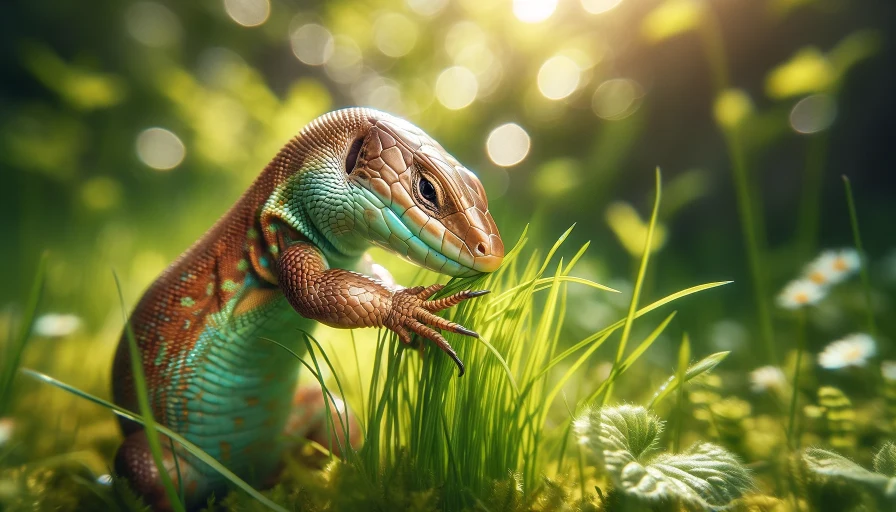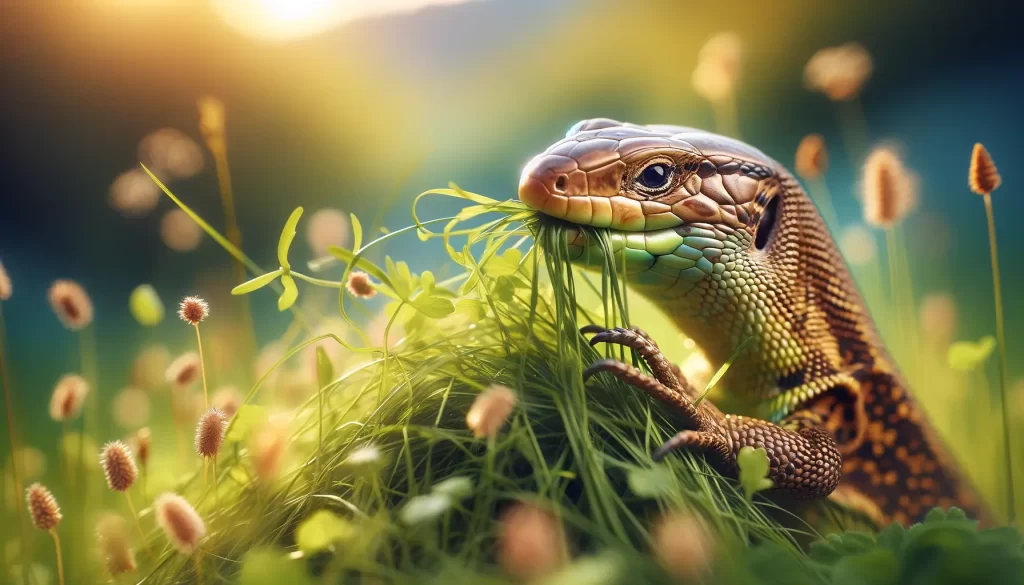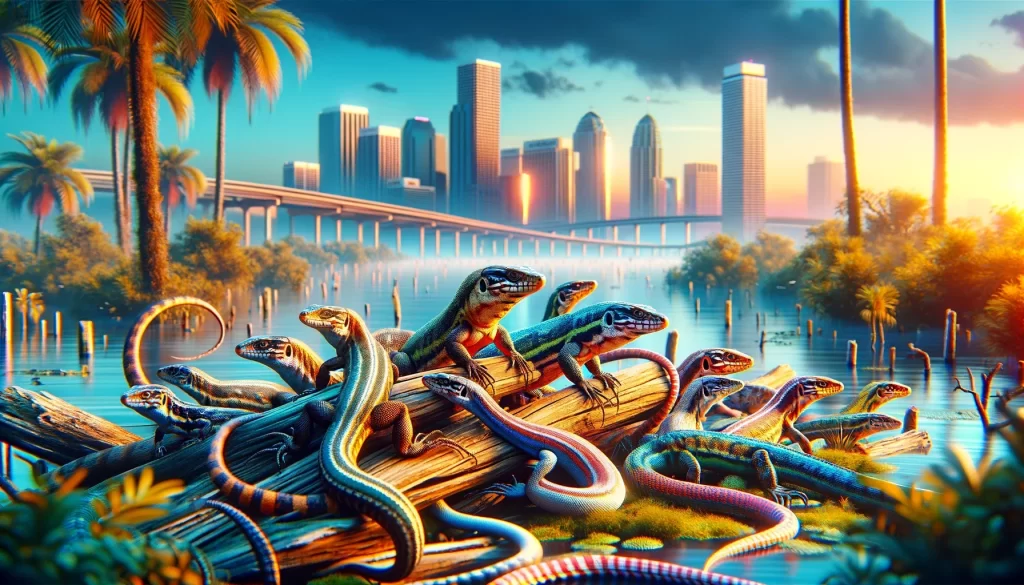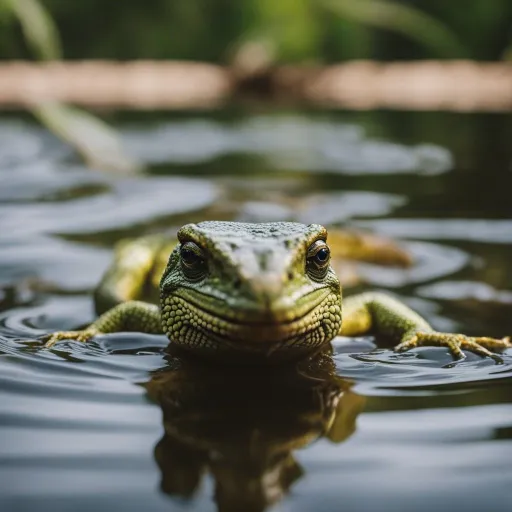So you’re curious about whether lizards can munch on grass? Well, it turns out that the answer isn’t as straightforward as you might think.
Yes, some species of lizards can eat grass, but it’s not a common part of their diet; primarily insectivores, they generally feast on a variety of insects and small prey. However, herbivorous lizards like iguanas are known to consume leafy greens as part of their diet.
However, certain herbivorous lizards, such as iguanas, are known to have a taste for leafy greens.
To truly understand the dietary habits of these scaly creatures, let’s take a closer look at the fascinating world of lizards and their relationship with grass.
Can Lizards Eat Grass?
When it comes to the dietary preferences and feeding habits of lizards, there is quite a bit of variation.
Some lizards are herbivorous, meaning they primarily eat plants, while others are carnivorous and rely on a diet of insects and small prey.
There are also lizards that fall into the omnivorous category, consuming both plants and animals.
With this in mind, the question arises: can lizards eat grass?

Types of Lizards
Before diving into the question of lizards and grass consumption, let’s first explore the different types of lizards out there.
Lizards belong to the reptile family and are categorized into various subgroups. These include iguanas, anoles, geckos, skinks, and many more.
Each subgroup has its own unique characteristics, habits, and dietary preferences.
Dietary Preferences of Lizards
Lizards have different dietary preferences based on their species. While some lizards are strict herbivores, others are pure carnivores.
There are also lizards that are capable of adapting to an omnivorous diet. Understanding the dietary preferences of a specific lizard species is crucial when it comes to providing them with a healthy and balanced diet in captivity.
Feeding Habits of Lizards
Lizards have specific feeding habits that align with their dietary preferences. Carnivorous lizards, for example, are active hunters, relying on their speed and agility to catch insects or small prey.
Herbivorous lizards, on the other hand, are more likely to be scavengers, feeding on various plant matter such as leaves, flowers, and fruits.
Omnivorous lizards tend to display a mix of both hunting and scavenging behaviors.
Herbivorous Lizards
Herbivorous lizards are primarily vegetarian and have evolved to consume a diet consisting mainly of plants.
Some well-known herbivorous lizards include iguanas and green anoles. They typically feed on a variety of vegetation, including leafy greens, fruits, flowers, and even some tree barks.
These lizards have specialized digestive systems that allow them to efficiently process plant matter.

Carnivorous Lizards
In contrast to herbivorous lizards, carnivorous lizards solely rely on a diet of flesh and insects. They are skilled hunters, using their keen senses and agility to hunt down their prey.
Examples of carnivorous lizards include monitor lizards and certain species of skinks. These lizards possess sharp teeth and powerful jaws that enable them to capture and devour their prey.
Omnivorous Lizards
Omnivorous lizards have a more flexible diet, consuming both plants and animals. This category includes lizards like bearded dragons and blue-tongued skinks.
Omnivorous lizards have a broader range of food options and may eat insects, small vertebrates, fruits, vegetables, and even some plant matter.
They possess a versatile digestive system that can handle both animal and plant proteins.
Evidence of Lizards Eating Grass
While lizards are not typically known for their grass consumption, there have been occasional reports and observations of lizards nibbling on grass.
However, such instances are relatively rare and not a common occurrence. Grass is generally not a significant part of a lizard’s natural diet, especially for species with specific dietary preferences.
Can Grass Be Part of a Lizard’s Diet?
While some lizards may occasionally snack on grass, it should not make up a substantial part of their diet.
There are several reasons for this.
Firstly, grass lacks essential nutrients that are crucial for a lizard’s overall health and well-being.
Secondly, the digestive systems of lizards are not well-equipped to process large amounts of plant matter efficiently.
Grass is high in cellulose, a complex carbohydrate that many lizards struggle to break down.
Hazards of Grass Consumption for Lizards
Although grass is not inherently toxic to lizards, excessive consumption can lead to several complications.
The cellulose content in grass can result in gastrointestinal problems, such as indigestion, blockages, or impactions.
These issues can be serious and potentially life-threatening for lizards. Additionally, grass that has been treated with herbicides, pesticides, or fertilizers can be toxic and should be strictly avoided.
What to Feed Your Pet Lizard Instead of Grass
Considering that grass is not an ideal food source for lizards, it’s essential to provide a balanced and appropriate diet for your pet lizard.
The specific dietary requirements will vary depending on your lizard’s species and individual needs.
In general, herbivorous lizards should be offered a variety of leafy greens, fruits, and vegetables.
Carnivorous lizards should be provided with a range of live insects and even small vertebrates. Omnivorous lizards will benefit from a combination of both plant and animal-based foods.
Final Thoughts
In conclusion, while it is possible for lizards to eat grass, it is not a dietary staple, and excessive consumption can be detrimental to their health.
Understanding the specific dietary preferences and feeding habits of your pet lizard is crucial for providing them with a nutritious diet.
By offering a balanced and appropriate diet for your lizard, you can ensure their overall well-being and help them thrive in captivity.
Frequently Asked Questions
Q: Are grasshoppers good for bearded dragons?
A: Yes, grasshoppers are good for bearded dragons. They are a nutritious source of protein and can be part of a balanced diet for bearded dragons, along with other insects and vegetables.
Q: What insects do lizards eat?
A: Lizards eat a variety of insects, including crickets, mealworms, waxworms, silkworms, and cockroaches. The specific types of insects they eat can vary based on the species of lizard.
Q: What should lizards not eat?
A: Lizards should not eat foods that are high in oxalates and phosphorus, such as spinach and avocado, as these can interfere with calcium absorption. Also, avoid feeding lizards insects caught in the wild due to the risk of pesticide exposure.
Q: What do lizards not like?
A: Lizards generally do not like strong smells, such as those from essential oils or chemicals. They also may not like loud noises or sudden movements, which can startle them.
Q: What is a wild lizard’s favorite food?
A: A wild lizard’s favorite food often depends on its species. Many prefer a diet of insects, including ants, flies, and beetles, while others may also eat fruits, leaves, and even small mammals or birds.
Q: Do any lizards not eat bugs?
A: Yes, some lizard species do not eat bugs. For example, adult marine iguanas feed primarily on algae, and the chuckwalla prefers fruits and leaves, showcasing the dietary diversity within lizard species.
Q: Do lizards eat caterpillars?
A: Yes, many lizards eat caterpillars. Caterpillars can be a part of the diet for several lizard species, providing them with a good source of protein.
Q: Do lizards eat mosquitoes?
A: Yes, lizards do eat mosquitoes. Mosquitoes can be a food source for many small lizard species, helping control mosquito populations in natural habitats.




